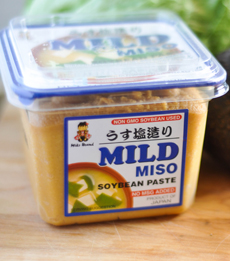TIP OF THE DAY: Why & How To Use Miso Paste
 [1] Miso paste with American label (photo courtesy Nagano).
|
Challenge yourself in the kitchen this year by trying a new ingredient each month. To start the year off, here’s a suggestion from our consulting chef, Johnny Gnall: miso paste.
Miso, a thick paste most often made from fermented soybeans,* is a traditional Japanese seasoning with which most Western cooks are unfamiliar. If you’ve eaten at a Japanese restaurant, you’ve likely enjoyed a bowl of miso soup. If you make fish recipes, you may have tried a variation of the exquisite miso-glazed cod that chef Nobu Matsuhisa made so popular in New York, Los Angeles and elsewhere. But miso rarely finds its way into American home kitchens. This is a shame, because it is a versatile and complex ingredient that can add depth and flavor across the culinary spectrum. Savory and salty, miso paste is low in calories and fat yet rich in protein, vitamins and minerals, making it an important part of Japanese cuisine. This healthy ingredient was a favorite of the Samurai, the noble warrior class that existed from the 12th century until pre-industrial times. It endures as a common ingredient in Japanese dishes, from pickled foods, sauces and spreads to the dish Americans know best, misoshiru or miso soup. But miso can be an important culinary tool beyond Japanese cuisine. Chef Johnny often uses it simply to add umami to dishes that would otherwise lack that certain something. The most common characteristic of miso, and arguably its defining attribute, is that elusive fifth taste: umami. Umami refers to that taste in foods that is often described as a “brothiness” or earthiness on the palate. Mushrooms and meat are the best-known ambassadors of umami. Here’s more to help you understand umami. Despite the difficulty one may have in describing it, umami plays an important role in cooking. Often you taste something and notice it lacks “strength” or seems “flat.” That absent quality you can’t seem to put your finger on is, quite often, umami. ________________ *In addition to soybeans, rice and barley can be used. Salt and the fungus kojikin complete the recipe. |
|
|
TYPES OF MISO Miso is available in different forms or flavors, such as red or white miso paste. The differences depend on exactly which ingredients were used in its fermentation (such as rice or barley), the amounts of such ingredients, and how long they were fermented. Red miso paste, for example, is often fermented for a year or longer, whereas white miso paste is fermented for a much shorter period. You can make your own homemade miso soup, of course, but try it in American recipes. The beauty of miso is its versatility. It can be the star, providing its own unique flavor out front, or it can be one of many ingredients, lending that umami quality to a dish in need. The flavor and umami from miso can be unbelievably satisfying, which makes it a great tool to have on hand. Yes, its sodium levels can be high; but compared with salt, you get far more flavor and complexity with less overall sodium, as well as bonus healthy minerals, beneficial bacteria and protein. You’ll even pick up some antioxidants. So the next time you are at the grocery store, head to the international foods aisle and locate the miso paste. There may be several varieties to choose from; choose any one to start. Different brands and types will have different levels of salty and/or sweet. Then, add it to anything you feel could use a boost of umami flavor and won’t hurt from a bit of saltiness. Get to know miso as more than just the soup you eat before the sushi. It may just be the secret ingredient you’ve been looking for: You just may become mad for miso—and that’s a good thing. |
 [4] Miso soup with tofu and garnishes (photo courtesy Sun Basket).
|
|
|
|
||



